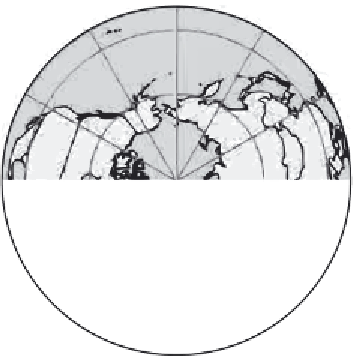Global Positioning System Reference
In-Depth Information
FIGURE A4.
A conceptual gyrocompass is shown edge-on at its initial position
a
. The
gyrocompass reorients itself during the day, as the earth rotates, so that its spin axis
points north-south. (At
b
the small circle with a dot in the center represents an arrow
pointing toward you; it is a component of gyroscope angular momentum that is
generated by gravitational torque.) The torque that causes this reorientation is
weakest at polar latitudes and strongest at the equator.
The gyrocompass now finds itself at position
c
and then
d
, with its spin axis (
CD
of fig. A3) now pointing due north. Further earth rotation moves the gyrocompass
to position
e
. Now you can see that the action of gravity exerts a torque that is
directed out of the page, as before, but this does not change the axis orientation,
which is already pointing in that direction. Thus, gravitational torque acts to
orient the axis so that it is parallel to the earth's rotation axis, but once the axis is so
oriented, the torque has no further e√ect, and the gyrocompass remains oriented
north-south.
It is the torque due to the force of gravity acting on the heavy case that causes
this reorientation of the gyroscope, turning it into a compass. Without the heavy
case there is no torque, and the gyroscope axis would remain in the orientation of
its initial position,
a
, all day.
The gyrocompass points to true north, not magnetic north, but it is not perfect.
The torque that brings about the axis reorientation is weak at polar latitudes
because the component of gravitational force acting in the plane of the paper in
figure A4 is weak at these latitudes. In practice, this means that gyrocompasses do
not work well at very high latitudes, north or south. Also, a gyrocompass of


















